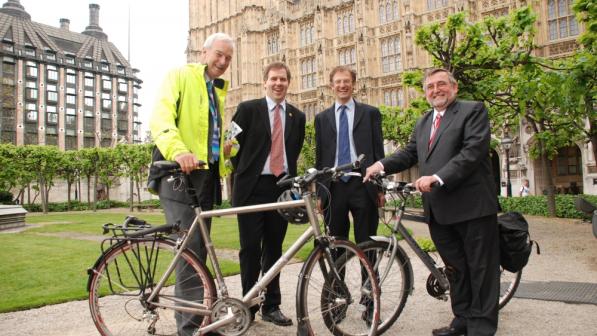Safety in numbers

About the campaign
In 2009, Cycling UK (then CTC) felt it high time to deal with a persistent problem: decision-makers and practitioners’ reluctance to encourage cycling for fear of increasing road casualties and, in doing so, failing to meet any targets to reduce the toll.
To tackle this, we examined the evidence for a different scenario: that cycling gets safer the more people cycle.
Hence our ‘Safety in Numbers’ report, which we launched in Parliament to a room packed with MPs on 7 May 2009.
To summarise, our research found that:
- Countries in Europe with high levels of cycle use tend to be less risky for cyclists
- Steep increases in cycling can go with reductions in cycle casualties (for example in London and the Netherlands)
- Every cycle trip that is a switch from car use means fewer injuries and deaths to others (see our regularly updated 10 Common Questions for more on the negligible harm caused by cyclists compared to drivers)
- Cycle commuting was safer in local authorities in England where cycling levels are high
Recognising that decision-makers tended to treat cycling as a risky activity which, in turn, played on the public’s fears and put people off, we also pointed out that:
- Cycling isn’t as risky as commonly thought (for our latest calculations of the risk, see our Cycling Statistics)
- The health benefits of cycling outweigh the risks by far anyway
It’s time for a shift in emphasis towards promoting cycling as a healthy, enjoyable activity. At the same time, we need to tackle the fears which deter people from doing it: encouraging more cyclists onto the roads will make the road network safer for everyone
In conclusion, we recommended:
- Reducing danger and fear through improving driver behaviour and the road environment, and funding schemes that promote cycling positively and build confidence
- Measuring fear and perception of danger
- Basing cycle safety targets on exposure (that is, reductions in casualties per mile or per hour, not on the absolute number of casualties). ‘Rate-based’ indicators like these account for levels of cycle use as well as the number of cyclist casualties (or serious or fatal casualties)
Update
Since 2009, further research (by Bhatia et al, Road Safety Analysis, Aldred et al, Fyhri et al and Elvik et al) has broadly re-affirmed the Safety in Numbers theory, namely that the number of people cycling and the safety of cycle use are correlated.
Indeed, the results of a large Ipsos survey conducted in 28 countries around the globe in 2022 suggest that the safer people feel, the more they cycle.
The Netherlands did far better than any other country – only 14% of respondents agreed that cycling from one place to another in their area was too dangerous, while 45% used their bikes as their primary mode of transport for a 2km/1 mile distance. The results for Great Britain were very different: 57% and 6% respectively.
It is unclear from the statistical analyses, however, whether increased cycle use results in improved cycle safety, or the other way round. Questions therefore remain about whether this is a causal relationship and, if so, in which direction.
Cycling UK suspects that the relationship probably works in both directions, though we recognise that this isn’t yet proven.
In other words, it seems very likely to us that creating safer cycling conditions will result in more people cycling, or doing so for more of their journeys, and that this increase can also be expected to improve cycle safety for the reasons we put forward in the report:
- The more people there are cycling in a given town, region or country, the more accustomed drivers are to interacting safely with cyclists
- The drivers themselves are also more likely to cycle for some of their journeys, and thus to understand the cyclists’ perspective
- Finally, increased cycle use will create greater pressure for increased investment in safe cycling conditions, as the ‘cycling vote’ gets stronger
Hence the relationship between ‘more’ and ‘safer’ cycling may well become self-reinforcing, as the safety in numbers effect grows stronger.
Cycling UK is still urging public bodies to measure the risk of a cycling casualty (or a serious or fatal casualty) per 100,000 trips or per million km, or similar (that is, a rate-based indicator).
When public bodies aim merely to reduce the number of cyclist casualties, this creates a perverse incentive simply to reduce cycle use, instead of increasing it – this makes no sense at all, given the health and environmental benefits of higher levels of cycling.
More and safer cycling can, and should, go hand in hand.
